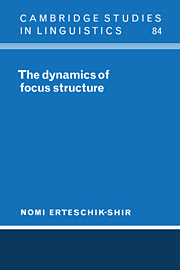Book contents
- Frontmatter
- Contents
- Acknowledgments
- Introduction
- 1 The interpretation of f-structure
- 2 Reference and coreference
- 3 Negation, questions, and contrast
- 4 The phonological interpretation of f-structure
- 5 Scope and R-dependencies
- 6 I-dependencies in focus structure
- Conclusion
- Notes
- References
- Index of names
- Index of subjects
4 - The phonological interpretation of f-structure
Published online by Cambridge University Press: 02 September 2009
- Frontmatter
- Contents
- Acknowledgments
- Introduction
- 1 The interpretation of f-structure
- 2 Reference and coreference
- 3 Negation, questions, and contrast
- 4 The phonological interpretation of f-structure
- 5 Scope and R-dependencies
- 6 I-dependencies in focus structure
- Conclusion
- Notes
- References
- Index of names
- Index of subjects
Summary
Under stress
In the previous chapters the level of f-structure was characterized as a projection of s-structure marked for Topic and Focus constituents. In those chapters f-structure was fine-tuned to take into account a variety of semantic properties. Three levels of f-structure were defined. 1. The main level of f-structure to which the rule of predication applies. 2. Subordinate f-structure that involves only the manipulation of the cards in the filing system, not assessment. 3. Metalinguistic f-structure that involves a different application of the predication rule. These three types of f-structure, however, have in common that they prompt the same operations on the file according to the rules of Topic, Focus, and Update.
In this chapter I propose one Phonological Form (PF) stress rule to account for intonation in English sentences:
Assign stress to the focus constituents.
(Duration, amplitude and pitch combine to give the effect of perceived stress.) This rule does not distinguish focus types and can be viewed as a simple linguistic marking of the focus rule: to place a new or existing card on top of the file. This, as I claimed in chapter 1, is tantamount to saying that the hearer's attention is drawn to the intension of the heading of this card. The stress rule reflects the fact that the speaker stresses what he intends the hearer to attend to. The stress rule applies to every focus in sentences with complex f-structures.
In proposing this rule to account for sentence stress, I side with those linguists who argue that sentence stress cannot be derived from s-structure alone.
- Type
- Chapter
- Information
- The Dynamics of Focus Structure , pp. 124 - 162Publisher: Cambridge University PressPrint publication year: 1998



